Effect of Zn Addition on the Microstructure and Discharge Performance of Mg-Al-Mn-Ca Alloys for Magnesium-Air Batteries
Abstract
:1. Introduction
2. Materials and Methods
3. Results
3.1. Microstructure
3.2. Discharge Performance
4. Discussion
4.1. Influence of Grain Boundary Density Characteristics on Discharge
4.2. Influence of Grain Texture on Discharge
5. Conclusions
- Microstructure Evolution:
- 2.
- Discharge Characteristics:
Author Contributions
Funding
Data Availability Statement
Acknowledgments
Conflicts of Interest
References
- Zhang, T.R.; Tao, Z.L.; Chen, J. Magnesium-air batteries: From principle to application. Mater. Horiz. 2014, 1, 196–206. [Google Scholar] [CrossRef]
- Tong, F.L.; Wei, S.H.; Chen, X.Z.; Gao, W. Magnesium alloys as anodes for neutral aqueous magnesium-air batteries. J. Magnes. Alloy. 2021, 9, 1861–1883. [Google Scholar] [CrossRef]
- Yuasa, M.; Huang, X.S.; Suzuki, K.; Mabuchi, M.; Chino, Y. Discharge properties of Mg-Al-Mn-Ca and Mg-Al-Mn alloys as anode materials for primary magnesium-air batteries. J. Power Sources 2015, 297, 449–456. [Google Scholar] [CrossRef]
- Deng, M.; Höche, D.; Lamaka, S.V.; Snihirova, D.; Zheludkevich, M.L. Mg-Ca binary alloys as anodes for primary Mg-air batteries. J. Power Sources 2018, 396, 109–118. [Google Scholar] [CrossRef]
- Chen, X.R.; Zou, Q.; Le, Q.C.; Hou, J.; Guo, R.Z.; Wang, H.N.; Hu, C.L.; Bao, L.; Wang, T.; Zhao, D.Z.; et al. The quasicrystal of Mg-Zn-Y on discharge and electrochemical behaviors as the anode for Mg-air battery. J. Power Sources 2020, 451, 10. [Google Scholar] [CrossRef]
- Yang, H.B.; Lei, B.; Wu, L.; Jiang, B.; Liu, W.J.; Yang, Q.; Song, J.F.; Huang, G.S.; Zhang, D.F.; Pan, F.S. Effects of Texture and Discharge Products on the Discharge Performance of Mg Anodes for Mg Air Batteries. J. Electrochem. Soc. 2020, 167, 13. [Google Scholar] [CrossRef]
- Liu, B.C.; Zhang, S.; Xiong, H.W.; Dai, W.H.; Ma, Y.L. Effect of Al Content on the Corrosion Behavior of Extruded Dilute Mg-Al-Ca-Mn Alloy. Acta Metall. Sin. Engl. Lett. 2023, 36, 77–90. [Google Scholar] [CrossRef]
- Zeng, G.; Xian, J.W.; Gourlay, C.M. Nucleation and growth crystallography of Al8Mn5 on B2-Al(Mn,Fe) in AZ91 magnesium alloys. Acta Mater. 2018, 153, 364–376. [Google Scholar] [CrossRef]
- Li, Z.; Gao, S.; Sasaki, T.T.; Nakata, T.; Kamado, S.; Tsuji, N.; Hono, K. Discontinuous yielding phenomena triggered by Zn addition in low-alloyed Mg-Al-Ca-Mn alloys. Scr. Mater. 2022, 221, 7. [Google Scholar] [CrossRef]
- Eom, D.; Yi, S.; Letzig, D.; Park, N.J. Effects of Zn Addition and Twin Roll Casting Process on the Microstructure, Texture, and Mechanical Properties of the Mg-Al-Mn-Ca Sheet. Metals 2024, 14, 261. [Google Scholar] [CrossRef]
- Yang, H.B.; Wu, L.; Jiang, B.; Lei, B.; Liu, W.J.; Song, J.F.; Huang, G.S.; Zhang, D.F.; Pan, F.S. Effects of Grain Size on the Corrosion and Discharge Behaviors of Mg-Y Binary Alloys for Mg-Air Batteries. J. Electrochem. Soc. 2020, 167, 13. [Google Scholar] [CrossRef]
- Ralston, K.; Birbilis, N. Effect of grain size on corrosion: A review. Corrosion 2010, 66, 075005–075005-13. [Google Scholar] [CrossRef]
- Yang, H.B.; Wu, L.; Jiang, B.; Liu, W.J.; Song, J.F.; Huang, G.S.; Zhang, D.F.; Pan, F.S. Clarifying the roles of grain boundary and grain orientation on the corrosion and discharge processes of α-Mg based Mg-Li alloys for primary Mg-air batteries. J. Mater. Sci. Technol. 2021, 62, 128–138. [Google Scholar] [CrossRef]
- Li, Y.Q.; Li, F.; Kang, F.W.; Du, H.Q.; Chen, Z.Y. Recent research and advances in extrusion forming of magnesium alloys: A review. J. Alloys Compd. 2023, 953, 14. [Google Scholar] [CrossRef]
- He, Y.Y.; Bai, S.W.; Fang, G. Coupled CA-FE simulation for dynamic recrystallization of magnesium alloy during hot extrusion. J. Magnes. Alloy. 2022, 10, 769–785. [Google Scholar] [CrossRef]
- Peng, P.; Zhang, L.P.; Zhao, J.Y.; Ran, C.H.; Wang, B.; Long, S.; Yang, Q.S.; Dai, Q.W. Simultaneous improvement of strength and ductility in ZK60 magnesium alloy by constructing the bimodal grain structure. J. Mater. Res. Technol. 2023, 22, 1026–1038. [Google Scholar] [CrossRef]
- Rong, W.; Zhang, Y.; Wu, Y.J.; Chen, Y.L.; Sun, M.; Chen, J.; Peng, L.M. The role of bimodal-grained structure in strengthening tensile strength and decreasing yield asymmetry of Mg-Gd-Zn-Zr alloys. Mater. Sci. Eng. A-Struct. Mater. Prop. Microstruct. Process. 2019, 740, 262–273. [Google Scholar] [CrossRef]
- Li, M.; Wang, X.; Xiao, Z.; Liu, Y.; Huang, Y. Effect of dynamic recrystallization, LPSO phase, and grain boundary segregation on heterogeneous bimodal microstructure in Mg-9.8 Gd-3.5 Y-2.0 Zn-0.4 Zr alloy. J. Mater. Res. Technol. 2023, 26, 3863–3880. [Google Scholar] [CrossRef]
- Rezaei, A.; Mahmudi, R.; Cayron, C.; Loge, R.E. Superplastic behavior of a severely deformed Mg-6Gd-3Y-0.5Ag alloy. Mater. Sci. Eng. A-Struct. Mater. Prop. Microstruct. Process. 2021, 802, 15. [Google Scholar] [CrossRef]
- Zeng, Z.R.; Zhu, Y.M.; Xu, S.W.; Bian, M.Z.; Davies, C.H.J.; Birbilis, N.; Nie, J.F. Texture evolution during static recrystallization of cold-rolled magnesium alloys. Acta Mater. 2016, 105, 479–494. [Google Scholar] [CrossRef]
- Robson, J.D.; Henry, D.T.; Davis, B. Particle effects on recrystallization in magnesium-manganese alloys: Particle-stimulated nucleation. Acta Mater. 2009, 57, 2739–2747. [Google Scholar] [CrossRef]
- Wang, Q.H.; Song, J.F.; Jiang, B.; Tang, A.T.; Chai, Y.F.; Yang, T.H.; Huang, G.S.; Pan, F.S. An investigation on microstructure, texture and formability of AZ31 sheet processed by asymmetric porthole die extrusion. Mater. Sci. Eng. A Struct. Mater. Prop. Microstruct. Process. 2018, 720, 85–97. [Google Scholar] [CrossRef]
- Jiang, M.G.; Xu, C.; Yan, H.; Fan, G.H.; Nakata, T.; Lao, C.S.; Chen, R.S.; Kamado, S.; Han, E.H.; Lu, B.H. Unveiling the formation of basal texture variations based on twinning and dynamic recrystallization in AZ31 magnesium alloy during extrusion. Acta Mater. 2018, 157, 53–71. [Google Scholar] [CrossRef]
- Wu, J.L.; Jin, L.; Dong, J.; Wang, F.H.; Dong, S. The texture and its optimization in magnesium alloy. J. Mater. Sci. Technol. 2020, 42, 175–189. [Google Scholar] [CrossRef]
- Ding, H.L.; Shi, X.B.; Wang, Y.Q.; Cheng, G.P.; Kamado, S. Texture weakening and ductility variation of Mg-2Zn alloy with CA or RE addition. Mater. Sci. Eng. A Struct. Mater. Prop. Microstruct. Process. 2015, 645, 196–204. [Google Scholar] [CrossRef]
- Lopez-Sanchez, M.A.; Tommasi, A.; Barou, F.; Quey, R. Dislocation-driven recrystallization in AZ31B magnesium alloy imaged by quasi-in situ EBSD in annealing experiments. Mater. Charact. 2020, 165, 16. [Google Scholar] [CrossRef]
- Barrett, C.D.; Imandoust, A.; Oppedal, A.L.; Inal, K.; Tschopp, M.A.; El Kadiri, H. Effect of grain boundaries on texture formation during dynamic recrystallization of magnesium alloys. Acta Mater. 2017, 128, 270–283. [Google Scholar] [CrossRef]
- Zhang, Y.; Jiang, H.T.; Wang, Y.J.; Xu, Z. Effects of Second-Phase Particles on Microstructure Evolution in Mg-2Zn Based Magnesium Alloys during Annealing Treatment. Metals 2020, 10, 777. [Google Scholar] [CrossRef]
- Yu, M.D.; Cui, Y.C.; Wang, J.Y.; Chen, Y.W.; Ding, Z.G.; Ying, T.; Llorca, J.; Zeng, X.Q. Critical resolved shear stresses for slip and twinning in Mg-Y-Ca alloys and their effect on the ductility. Int. J. Plast. 2023, 162, 20. [Google Scholar] [CrossRef]
- Liu, B.Y.; Liu, F.; Yang, N.; Zhai, X.B.; Zhang, L.; Yang, Y.; Li, B.; Li, J.; Ma, E.V.; Nie, J.F.; et al. Large plasticity in magnesium mediated by pyramidal dislocations. Science 2019, 365, 73–75. [Google Scholar] [CrossRef]
- Liu, X.; Xue, J.L.; Zhang, P.J.; Wang, Z.J. Effects of the combinative Ca, Sm and La additions on the electrochemical behaviors and discharge performance of the as-extruded AZ91 anodes for Mg-air batteries. J. Power Sources 2019, 414, 174–182. [Google Scholar] [CrossRef]
- Li, Q.; Xiong, W.; Yu, M.H.; Li, J.; Liu, L.; Zhu, G.; Wang, L.Y.; Wang, J.; Yu, S.R.; Liu, E.Y. Effect of Ce content on performance of AZ31 magnesium alloy anode in air battery. J. Alloys Compd. 2022, 891, 9. [Google Scholar] [CrossRef]
- Fan, L.; Lu, H.M. The effect of grain size on aluminum anodes for Al-air batteries in alkaline electrolytes. J. Power Sources 2015, 284, 409–415. [Google Scholar] [CrossRef]
- Wang, Y.J.; Zhang, Y.; Jiang, H.T. Effect of grain size uniformity and crystallographic orientation on the corrosion behavior of Mg-2Zn-1Al bar. Mater. Charact. 2021, 179, 9. [Google Scholar] [CrossRef]
- Zhang, S.A.; Liu, B.C.; Li, M.X.; Wang, H.Y.; Ma, Y.L. Effect of Microstructures and Textures on Different Surfaces on Corrosion Behavior of an as-Extruded ATZ411 Magnesium Alloy Sheet. Acta Metall. Sin. Engl. Lett. 2021, 34, 1029–1041. [Google Scholar] [CrossRef]


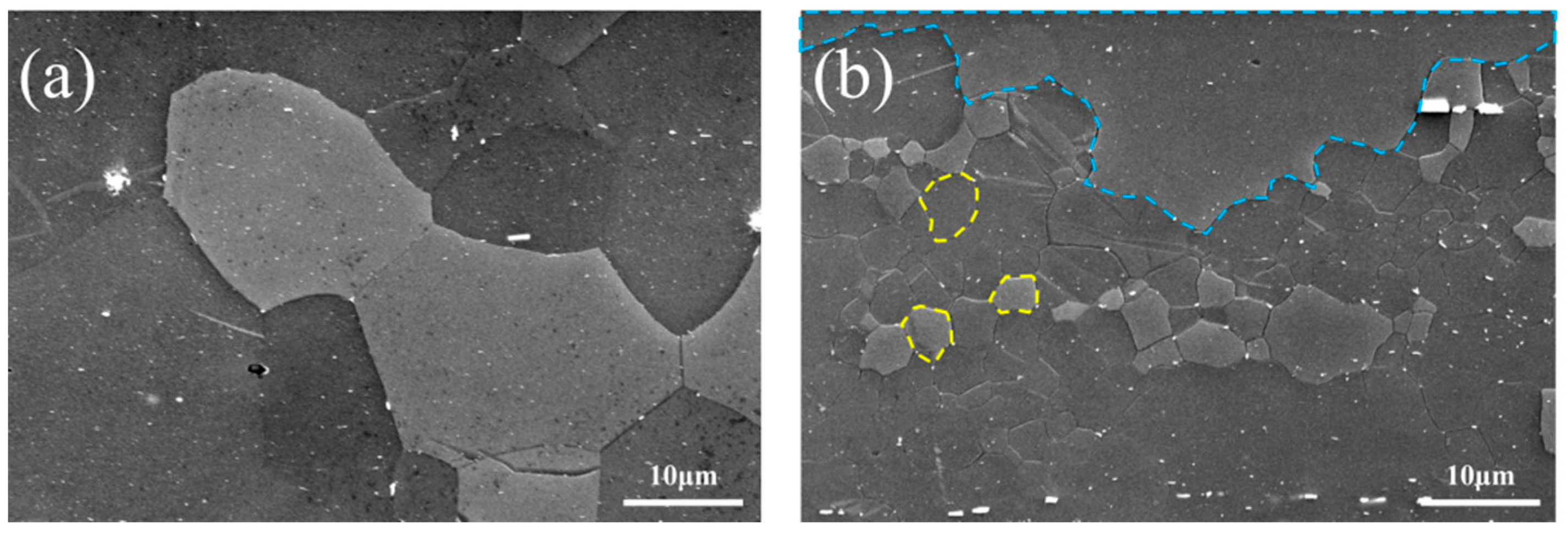
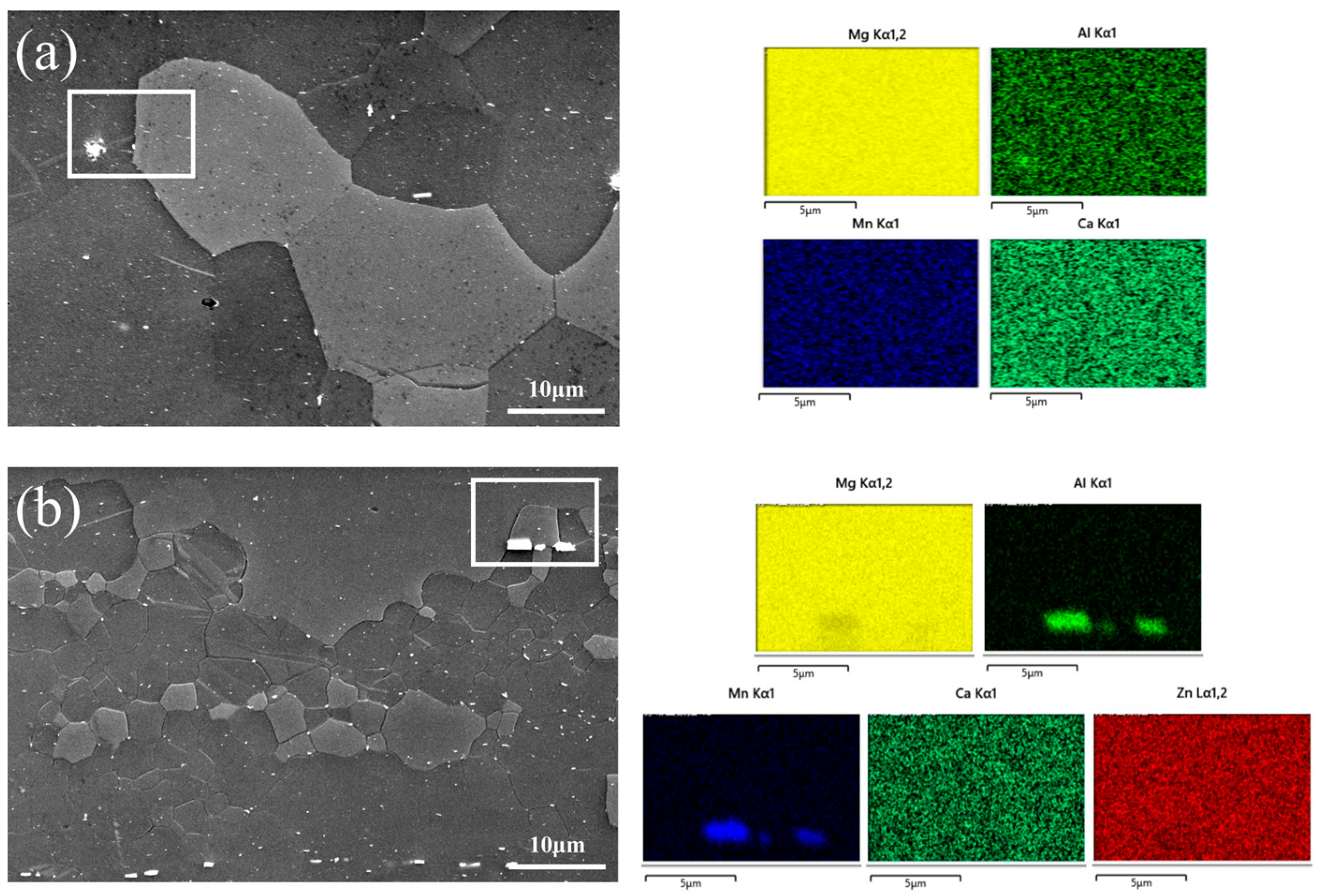



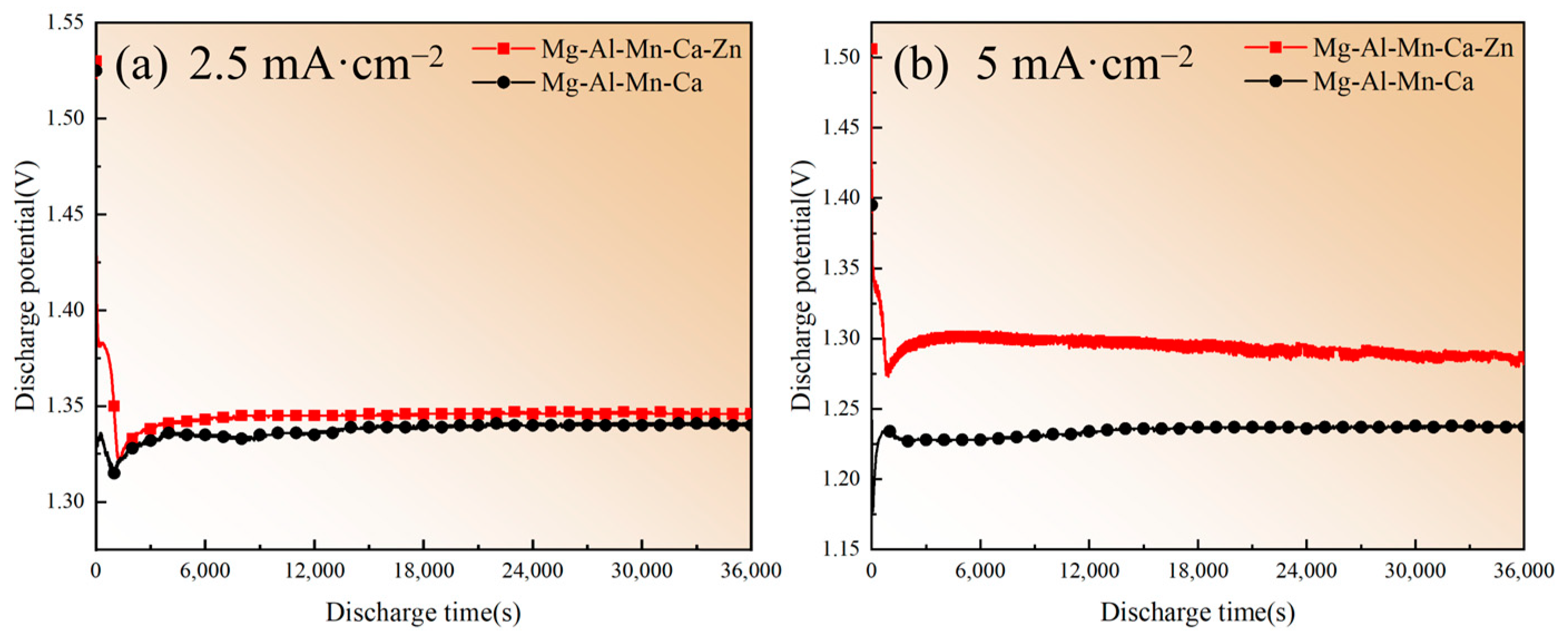
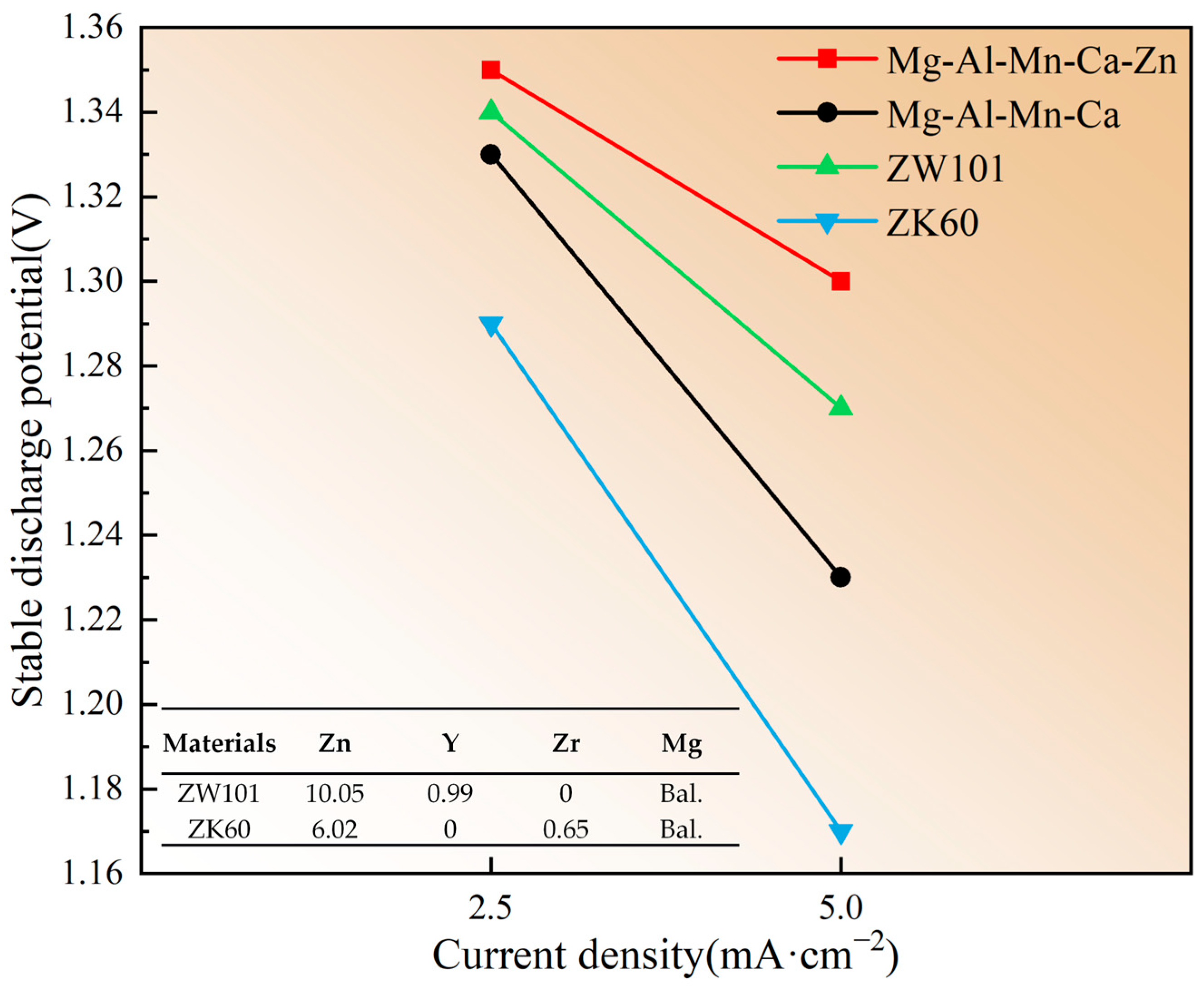
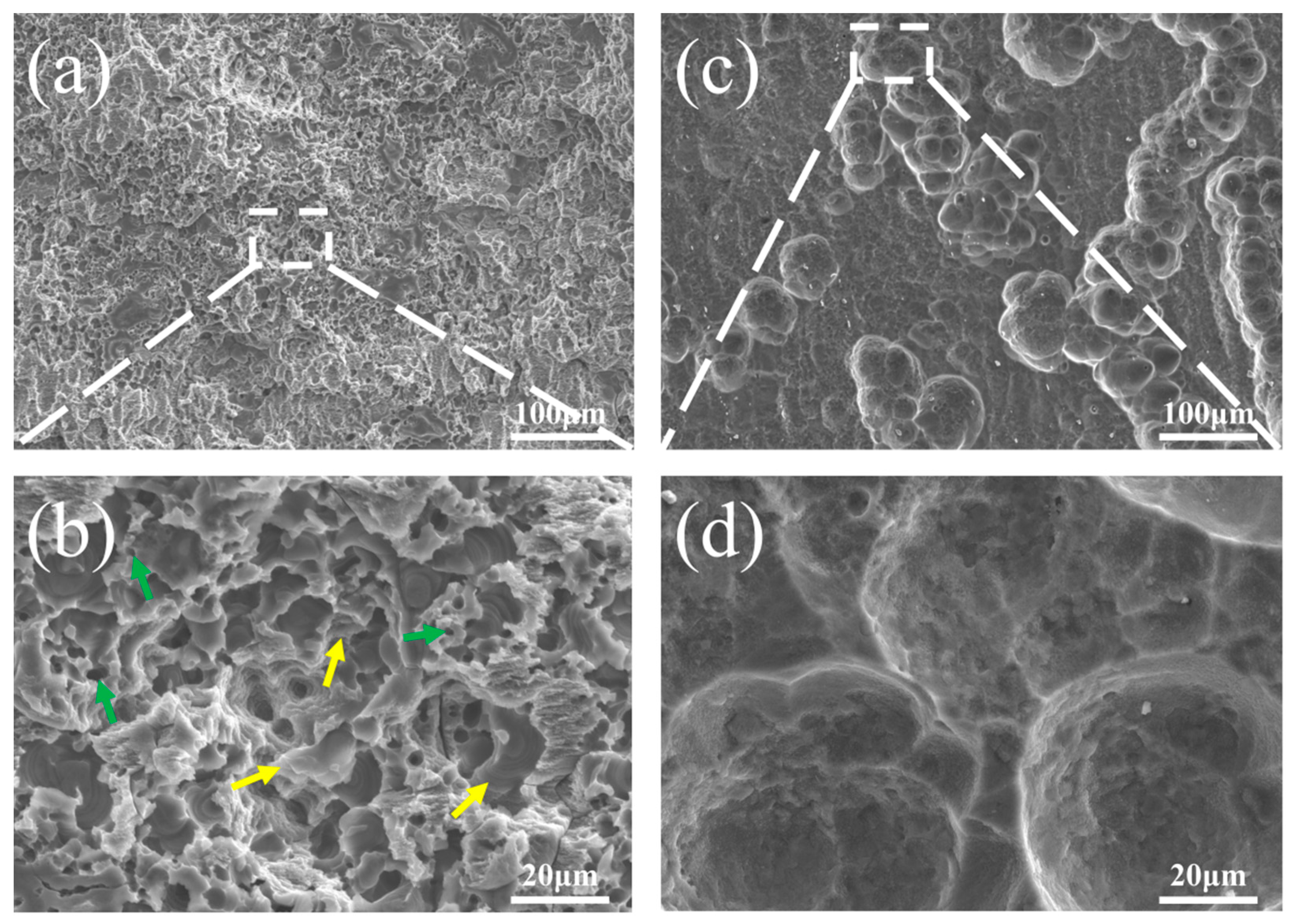
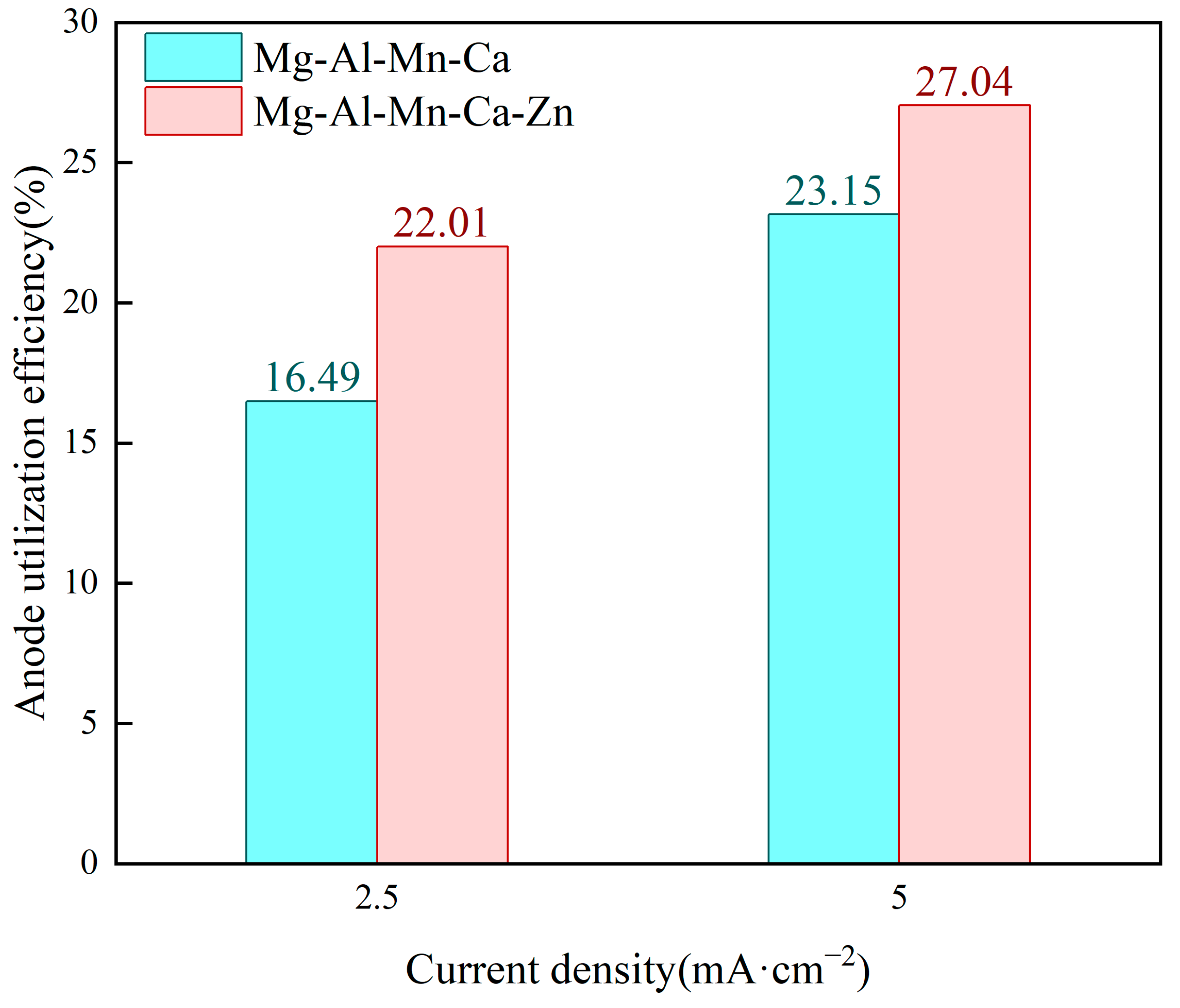
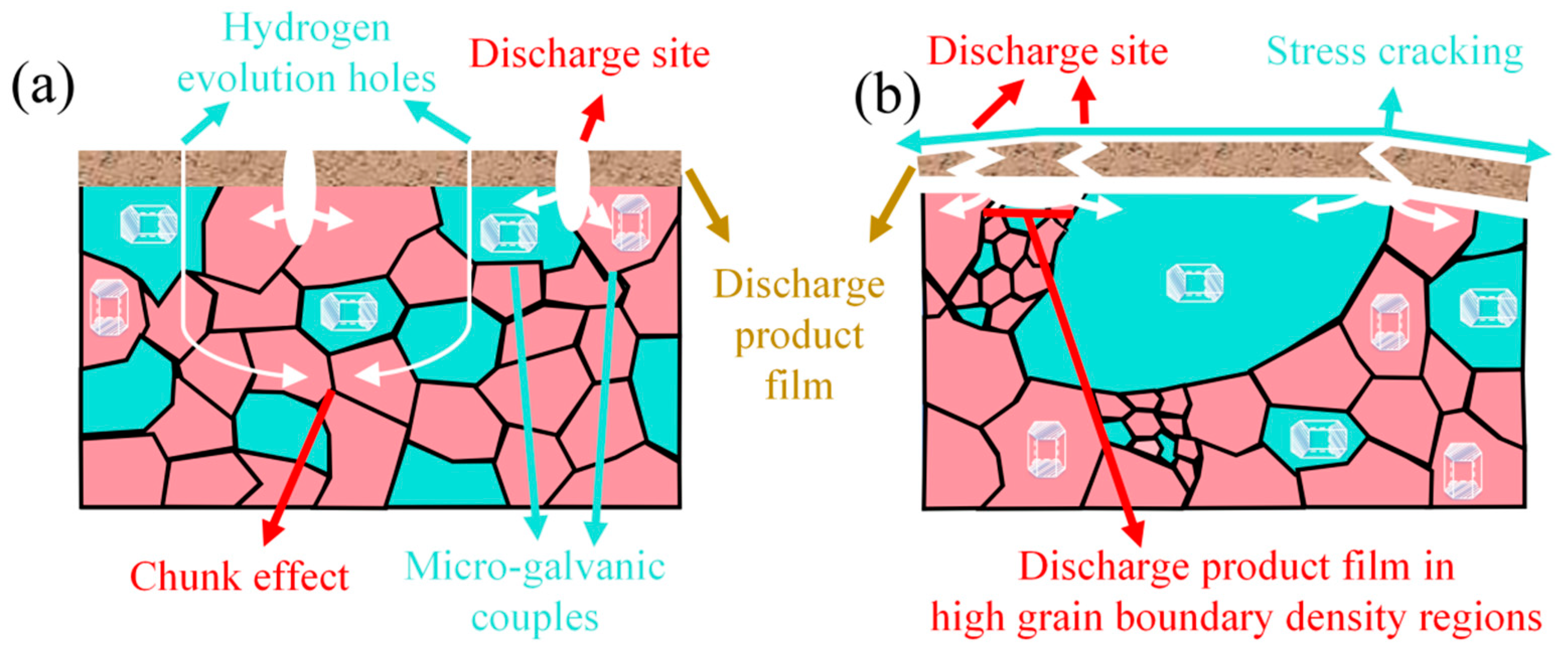
| Elements | Al | Ca | Mn | Zn | Mg |
|---|---|---|---|---|---|
| wt.% | 1.20 | 0.10 | 0.50 | 0 | Bal. |
| wt.% | 1.20 | 0.13 | 0.50 | 1.30 | Bal. |
Disclaimer/Publisher’s Note: The statements, opinions and data contained in all publications are solely those of the individual author(s) and contributor(s) and not of MDPI and/or the editor(s). MDPI and/or the editor(s) disclaim responsibility for any injury to people or property resulting from any ideas, methods, instructions or products referred to in the content. |
© 2024 by the authors. Licensee MDPI, Basel, Switzerland. This article is an open access article distributed under the terms and conditions of the Creative Commons Attribution (CC BY) license (https://creativecommons.org/licenses/by/4.0/).
Share and Cite
Gong, Y.; Wei, K.; Jiang, W.; Xiang, C.; Ding, H.; Wang, Z. Effect of Zn Addition on the Microstructure and Discharge Performance of Mg-Al-Mn-Ca Alloys for Magnesium-Air Batteries. Metals 2024, 14, 1014. https://doi.org/10.3390/met14091014
Gong Y, Wei K, Jiang W, Xiang C, Ding H, Wang Z. Effect of Zn Addition on the Microstructure and Discharge Performance of Mg-Al-Mn-Ca Alloys for Magnesium-Air Batteries. Metals. 2024; 14(9):1014. https://doi.org/10.3390/met14091014
Chicago/Turabian StyleGong, Yiwei, Kezheng Wei, Wenlong Jiang, Chongchen Xiang, Hanlin Ding, and Zijian Wang. 2024. "Effect of Zn Addition on the Microstructure and Discharge Performance of Mg-Al-Mn-Ca Alloys for Magnesium-Air Batteries" Metals 14, no. 9: 1014. https://doi.org/10.3390/met14091014






